 Email: support@vespaagogo.com
Email: support@vespaagogo.comCultural Insights
- Home
- Travel Tips
Beyond the Sights: An Insider’s Guide to the Soulful Music of Vietnam
2025-09-01
So, you're coming to Vietnam! That's awesome. I’m sure your to-do list is already exploding with incredible food tours, breathtaking landscapes, maybe even a lesson in how to cross the street in HCMC - and of course, the excitement of getting to wear the graceful, flowing Áo Dài.
But hey, if you want to unlock a deeper level of this amazing country, a layer that most tourists miss, you need to listen.
I’m not talking about the latest V-Pop hits you'll hear in the coffee shops. I'm talking about the OG soundtrack of Vietnam - melodies so foundational, so packed with history and soul, that they've been officially crowned by UNESCO as World Intangible Cultural Heritage. Yeah, it's a big deal. Think of it as the nation's secret playlist, and I'm about to give you the inside scoop.
This isn't just a list; it's a musical road trip from the ancient villages of the North to the soulful riverbanks of the South. I'll be your friendly local guide, showing you not just what to hear, but how to feel it.
Quan Họ Folk Songs: The Art of a Lyrical Love Duel
Our first stop is in the lush, green heartland of the Red River Delta, near Hanoi. Now, forget what you know about modern dating. In Bac Ninh province, for centuries, the ultimate romantic gesture has been a Quan Họ sing-off. It's a tradition that is as much about community as it is about courtship.
Imagine this scene: you're on a small boat, floating on a peaceful river. Two ornate dragon boats drift towards each other. On one, you have the liền anh ("brother" singers), and on the other, the liền chị ("sister" singers). The women are absolutely radiant in their traditional áo tứ thân, a beautiful four-panel dress. And let me tell you, this isn't just a pretty outfit, it's a timeless symbol of the grace, modesty, and quiet strength of Northern Vietnamese women.
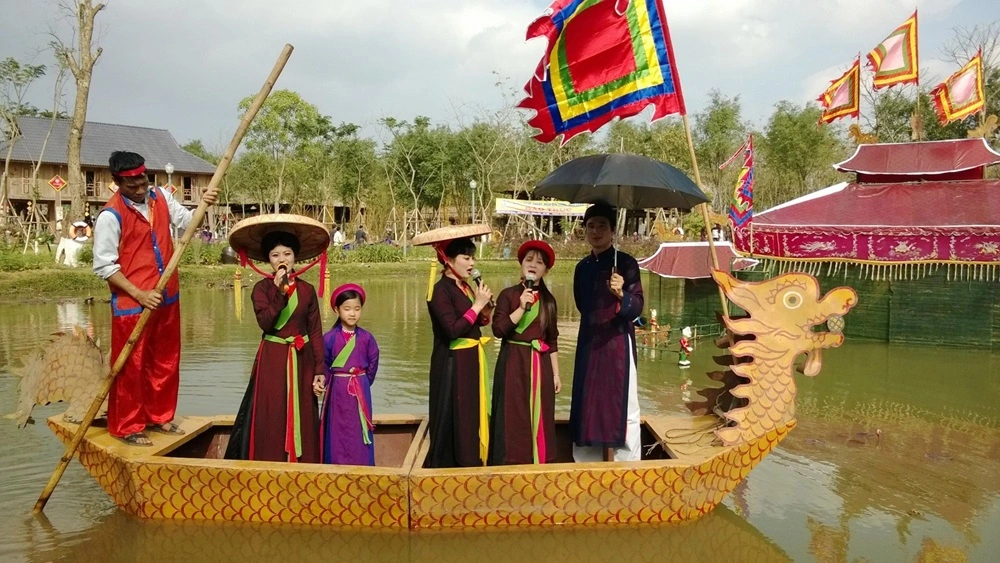
Familiar costumes of artists when performing quan ho folk songs
Then, the magic starts. It’s not a concert; it’s a living, breathing poetic battle of wits and hearts. The men will sing a verse, often a beautifully crafted piece of poetry, challenging the women. The women must then respond with the same melody but with entirely new lyrics that are equally clever and beautiful. They sing about the moon, the sadness of parting, the joy of meeting. The rules are strict, the melodies are complex, and the whole affair is governed by a deep sense of mutual respect. You don't need to understand a single word to feel the playful tension, the longing, and the profound romance of it all.
- Where to watch Quan Họ Folk Songs: A day trip to Bac Ninh province is the best way to get an authentic feel. If you can, go during a local spring festival. The entire region comes alive with music, and it’s an experience you'll never forget.
Tally Card Songs: Vietnam's Ancient, Intellectual Speakeasy Music
From the open-air romance of the countryside, our journey takes us into the quiet, scholarly chambers of Hanoi's Old Quarter. The energy here is completely different - it's focused, intense, and deeply intellectual. Welcome to the world of Tally Card Songs (Ca Trù).
This is one of Vietnam’s most ancient and sophisticated art forms, a direct reflection of the deep historical respect for poetry and scholarship in our culture. It thrived in royal courts before becoming the chosen entertainment of scholars and aristocrats. The performance is an intimate and fascinating trio. Your focus is immediately drawn to the ca nương, the female singer. Her vocal control is simply mind-blowing, and she accompanies herself by striking a phách, a small bamboo plank, creating a crisp, sharp rhythm. Next to her, a musician plays the đàn đáy, a long-necked lute with three strings that produces a deep, contemplative sound.
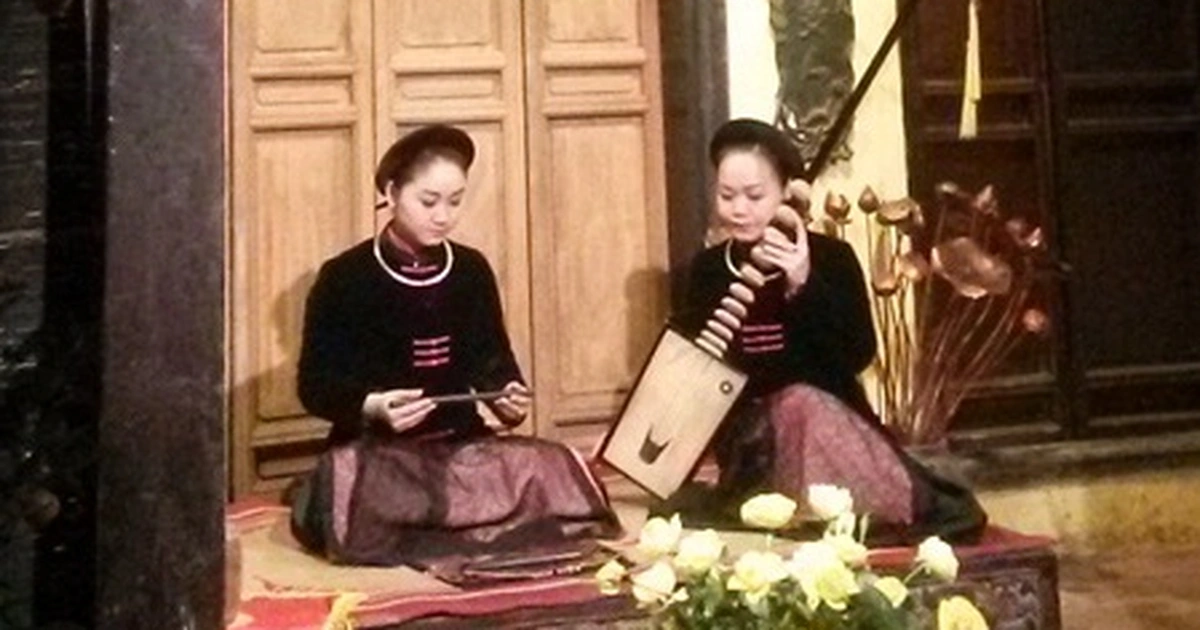
Ca Nuong, phach, and dan day are indispensable symbols of Ca Tru
But here’s the wild card, the part that makes tally card songs so unique: the trống chầu, or "praise drum." This is played by someone from the audience, usually a connoisseur of the art form. When he hears a particularly masterful vocal run or a clever line of poetry, he gives the drum a sharp "thwack" of approval. It’s essentially the original, analog "like" button, creating a thrilling, real-time dialogue between the performer and the listener. It feels less like a concert and more like being invited to a secret society of music and poetry lovers.
- Where to watch Tally Card Songs: The intimate setting is everything. Seek out the small, dedicated tally card songs clubs in Hanoi. Being just a few feet away from the artists allows you to catch every subtle nuance of this incredible art form.
Hue Royal Court Music: The Epic, Imperial Soundtrack of Hue
Alright, prepare to feel like royalty. We’re journeying south to the former imperial capital of Hue, and the music here gets a serious upgrade in scale and grandeur. Hue Royal Court Music (Nhã Nhạc) literally means "elegant music," but a better translation might be "the official soundtrack of emperors."
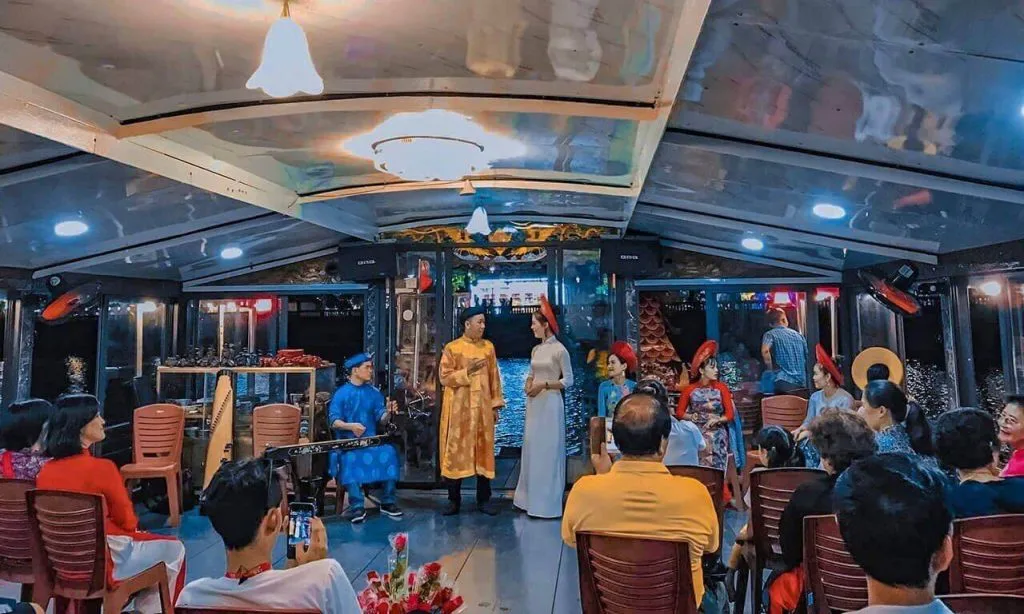
Enjoying Hue Royal Court Music on the Perfume River is an indispensable part.
This is the music that filled the halls of the Forbidden Purple City, the sound that accompanied the most important ceremonies of the Nguyen Dynasty. It’s majestic, solemn, and powerful. Rooted in Confucian ideals of harmony and social order, every single note was designed to reflect the emperor’s power and his connection to the heavens. The orchestra is huge and features incredible instruments you won't see anywhere else, from giant bronze bells and resonant stone chimes (biên khánh) to massive drums (đại cổ) that seem to shake the very ground. Listening to Nhã Nhạc inside the ancient walls of the Hue Citadel is a powerful experience - it's as close as you can get to truly hearing the sound of imperial Vietnam.
- Where to watch Hue Royal Court Music: While the shows inside the Citadel are fantastic, for a truly magical evening, find a performance on a smaller, family-run dragon boat on the Perfume River. Drifting on the water at night, listening to this ancient music, is an experience that feels straight out of a movie.
The Gong Culture of the Central Highlands: The Earth's Primal Heartbeat
Take off your royal crown and put on your hiking boots. We’re leaving the palaces behind and heading deep into the wild, rugged mountains of the Central Highlands. The music here is something else entirely. It's not written, it's forged. It's not delicate, it's powerful. This is the Space of Gong Culture.
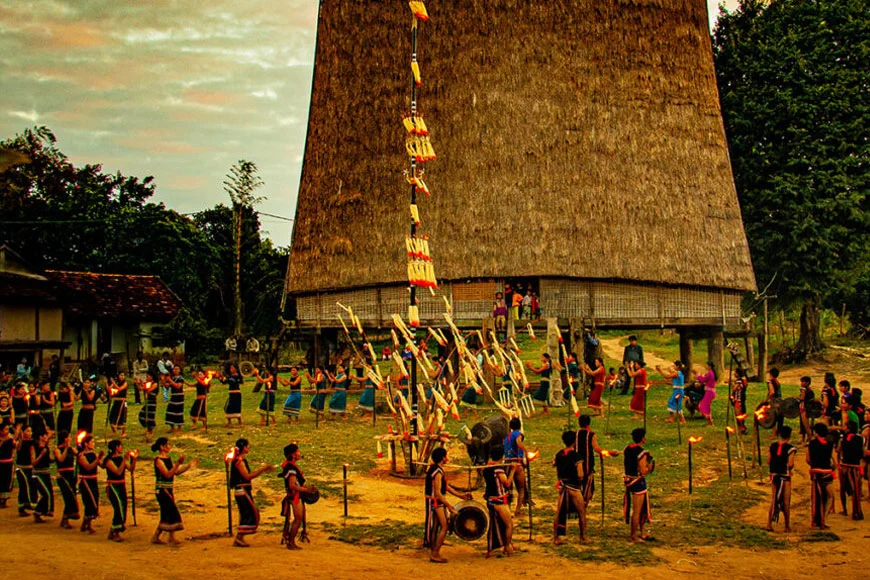
The Gong Culture of the Central Highlands is the sacred thread weaving together the heavens, the earth, and the very soul of its people.
For the many ethnic groups who call these mountains home, gongs are everything. They are a sacred language to speak with the gods, a symbol of a family's wealth and prestige, and an essential part of every single life event. I'll never forget the first time I experienced this. It’s not just a sound you hear, it's a physical force you feel in your bones. A group of villagers moves in a ritualistic circle, each person holding a different gong, and together they weave a complex, thundering rhythm that fills the air and seems to vibrate up from the earth itself. It’s raw, primal, and will give you goosebumps.
- Where to watch The Gong Culture of the Central Highlands: Visiting a cultural village near cities like Pleiku or Kon Tum is a great way to experience this. You can see the gongs up close, and the local people are often proud to share the stories and significance behind their most sacred tradition.
Southern amateur music: The Soulful Front-Porch Jams of the South
Our epic musical journey concludes in the lush, laid-back Mekong Delta, where the spirit of the river itself seems to flow through the music. This is Southern amateur music (Đờn Ca Tài Tử), and it’s pure, unadulterated soul.
The best way I can describe it is as a Vietnamese front-porch blues session. It reflects the Southern character perfectly: warm, generous, emotional, and resilient. After a long day, friends and neighbors will gather with their instruments - the beautiful, moon shaped fretted lute (đàn kìm), the shimmering 16-string zither (đàn tranh). They play from a foundational repertoire of 20 "ancestral songs," but the real beauty is in the improvisation. Each artist is free to "bend" the notes, pouring their personal feelings and story into the music. It’s often filled with a profound, bittersweet emotion the Vietnamese call buồn. It’s not just "sadness"—it’s a deep, reflective, and beautiful feeling about the joys and sorrows of life. It’s incredibly human.
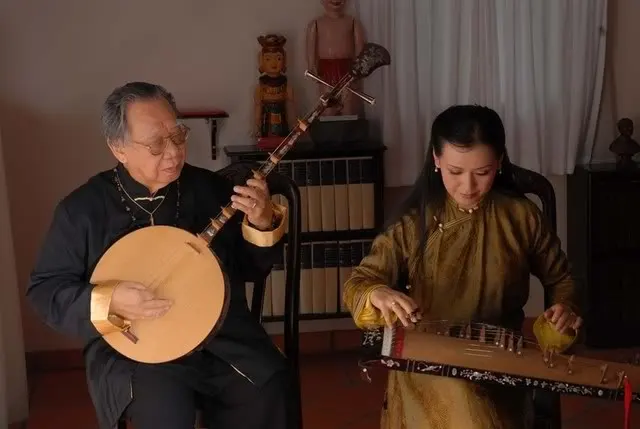
Moon shaped fretted lute and the shimmering 16-string zither
- Where to watch Southern amateur music: This is perhaps the most heartwarming and accessible music to experience. If you're staying at a homestay in the Mekong Delta (which you totally should!), ask your host about it. Being invited to listen to an informal evening session is a priceless cultural experience.
Your Backstage Pass: How to Actually Hear This Stuff
- Go to the source: for the most authentic vibe, try to experience the music in its homeland. It just hits differently.
- A little etiquette goes a long way: this music is deeply loved and respected. The best thing you can do is just be a present, respectful audience. Silence your phone, listen with an open heart, and applaud warmly. A simple, smiling "Hay quá!" (sounds like "High-hwa," and means "Excellent!") will be the best compliment you can give.
- Listen with your heart: try to feel the story behind the music - the romance, the intellect, the grandeur, the raw power, the deep soul.
You've just taken a wonderful journey through heritage to understand the depth of Vietnam's past. Now, it's time for a different kind of journey - an adventure to feel the energy and vitality of the present.
That is exactly what a Vespa A Go Go tour offers: the opportunity to weave through every street corner, find your own stories, and create the most authentic memories. That's how you turn a trip into an experience of a lifetime.

Excited guests exploring Saigon with Vespa A Go Go
Other tips
- Is the Water Puppet Show Worth It? An Honest Review & Deep Dive into Vietnamese Water Puppets History
- Celebrating Mid-Autumn Festival in Vietnam 2025 | The Ho Chi Minh City Insider's Guide
- What's happening on September 2nd in Vietnam? Vespa A Go Go Explains It All!
- Vietnam Independence Day: 80 Years. One Unforgettable Celebration
- Beyond the Sights: An Insider’s Guide to the Soulful Music of Vietnam
- Vietnamese tea: Sip for the hospitality and connection
- A Journey Through Important Vietnam War Battles (1954-1975): From the Local Perspectives
- The Living Altar: A Traveler's Guide to Ancestor Worship in Vietnam
- The Languages of Vietnam: A Colorful Chorus Through History and Today
- Christianity in Vietnam: Surprising facts & Iconic Churches
- Buddhism in Vietnam and the Weaving of a Nation's Soul

